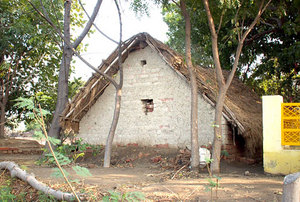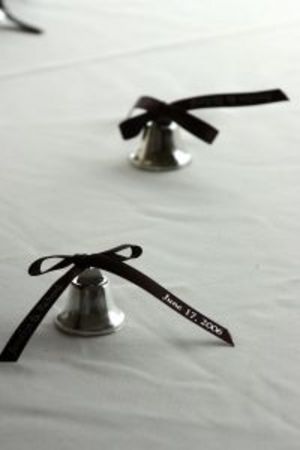India is full of interesting items – statues, literature, clothes, incense, herbal medicines – and our interest often exceeds our luggage allowance. Then, stuff needs to be shipped home. But how? This overview on sending a parcel to the West from an Indian post-office is inspired by today’s experiences on an exhausting day-trip to Vrindavana, a small north-Indian city and a place of pilgrimage.
First of all, remember that things in India always take their time. If you intend to get something mailed, reserve two hours for the process. If it takes less, then good for you – but wasting two hours for the task is not at all unheard of. I’ll first cover the principles and then conclude with the story.
Packing. Basically, you have two kinds of content. One is books only that may qualify for a separate, lower price, and the other is everything else. If books are shrink-wrapped or wrapped in bubble coated plastic and cartoon, or packed in an equivalent tight and sturdy way, they may be sent as they are. Everything else will have to be sewn tight inside a cotton cloth. Yes, you got it right – go and buy a piece of cotton and bring it to the tailor. Once it’s neatly packed, you will need to get some sealing wax and paste some around the joints. They may or may not require this, and may or may not be able to do this in the post office, but your best bet is to get it done yourself in advance. That’s the packing part.
Shipping. Then, you have a number of options for shipping. This only covers the options provided by India Post (indiapost.gov.in), though the packing convention is best observed with courier companies as well. First and fastest, you have the SpeedPost, which is the option of choice when you want the goods to be delivered fast and still for a price well below couriers – some 2200 Rs. for 5 kg. Unfortunately, they don’t cover some end-of-the-world countries yet. Then, you have regular Air Mail that takes about two weeks to reach its destination, a good deal cheaper than SpeedPost – sending a 5kg parcel to Europe comes to around 1500 Rs. Then, as the last option, you have sea mail that can be extremely slow, taking up to two or three months, but is by far the most economical option.
In the post office. Be aware that people may need to charge you for services that should be included in the price of sending the parcel. You may be asked for handling costs, or even for a service fee for a task as insignificant as gluing stamps on the parcel. If there’s a task out of the ordinary, however, do give a tip unless you want to risk making the rest of the mailing experience slow and miserable. Be sure to check that the target country gets spelled correctly (e.g. “Finland” instead of “Thailand” or “England”) and that you’re charged the proper fee. Be aware of the approximate price range for the shipment you’re about to send – swindling a Westerner is a common hobby in Indian offices. You may or may not need to fill in a customs declaration to accompany the parcel, this will depend on your destination.
And then, story time! To bring the theory to life. A while back, a friend had asked me to purchase a stock of neem-wooden japa-malas (rosaries) and get them shipped to Finland. Today, taking care of a number of small tasks alongside, I took care of the job. The stop at Chaitanya Tulasi was quick and smooth – eight twenty-piece packages were stuffed into a plastic sack and paid for in a matter of minutes. But that wouldn’t do for the post office – no, cotton it has to be. Five minutes away was Dinesh’s, a cloth store I frequently visit. One meter of thick cotton, 40 rupees, to be sown on the double he says, so as to not break on the road. Near enough I spot a tailor sitting by the road-side with an umbrella patched up to shield him from the blazing sun. He isn’t a tailor with a sewing machine, he’s a tailor with a needle and some thread. But he seems competent enough. “Accha, packing – thik hai. Pachis rupia.” Twenty-five rupees for the task, he tells me. I am to come back in half an hour to pick it up, and he’s well on time. “Double kar”, the whole cloth must be used to make it sturdy enough.
Smooth enough so far, now to the post office. When I mention air mail, a man at the branch at Loi Bazaar hands me an aerogram sheet. “Six keidzi parcel hai to.” He directs me to the main post office to get it sent, a brisk fifteen minute walk away. A rickshaw would have been an option, but I was in the mood for walking as I wanted to see the shops on the way – I still haven’t acquainted myself with the practical Vrindavana well enough. The main post office is located behind the city hall and the gate, a short distance from the grand Rangaji temple. “Daka Ghar”, “Letter house”, the sign says. Thank god it’s open even at half past noon in the afternoon, it wouldn’t have surprised me if they were all already on their respective lunch breaks. The main office closes at four, branches often close at two or three – be there in good time.
Then the grand finale, shipping the parcel away. The clerk at the post office directs me to come in through the backdoor with the parcel and get it to his scale. Looking at it, he tells me I need to seal it with wax, available from “the bazaar”. “Which bazaar?” I ask. “Any one over there,” he tells me. “Can’t you get it done here?” He gives me an ambiguous response, and we proceed. 5485 grams exactly, says the scale. He cracks open his computer, and I watch the boot screen with curiosity. Holy cowbits, he has a three gigahertz processor packed up in that ancient-looking box! He types in the address from the parcel into their system. I don’t bother with correcting the slight and humorous misspelling he makes on the street address, it’s written right on the parcel itself. The printer jams in the middle of printing the receipt, forcing him to reboot, cancel the parcel and re-enter it into the system – this time with a successful output.
The price is exactly exactly “1835 rupees and 0 paisa only”, the program tells both in numbers and in words. Then it’s crafts time! In come Mukesh and Rakesh with 1835 rupees worth of stamps and a stick of paper glue. The stamps are 15 rupees each, which means they are going to glue exactly 122 large stamps on my parcel. Greatly humored, I watch as the men spend fifteen minutes in covering more than 50% of the parcel’s surface with their stamps – and they aren’t ordinary stamps, they are sandalwood scented, yes they are! A third fellow, an English-speaking guy, informs me I should pay 50 rupees for the service. “Bahut hai!” Or then, at least twenty rupees, he says. “Tumhara boss kaham hai?” I ask, as I think this should really be included in the service, and I have time enough to have a chat with his boss if need be. He fades back to wherever it is that he came from.
As our hobbyists are done, I check in with the main clerk to see whether we’re done. “No, it needs to be sealed.” He directs me to an elderly man at a desk in the corner, who supposedly has some sealing wax stocked up. And indeed he finds a box with two bits and a stub of a candle. The man turns the fan off and attempts to light a match to light the candle, but the airflow from the surrounding fans keeps hampering his efforts. He ends up going under his desk and finally meets with success in lighting the candle, and on we go with sealing the joints. He spends about a quarter of an hour under his desk, pasting lumps of molten wax all around the parcel – in all those places not yet covered with the stamps – leveling them with his liner. “Bahut first-class hogea” is the verdict as I hand him a twenty rupee note he asked. This was, after all, an extra service and he did it with great devotion.
Returning to the main clerk with the finely sealed, stamped and polished parcel – “Kya abhi thik hai?” With an affirmative, he glues a receipt on the top and gives me leave, grabbing his lunch gear and taking a well-deserved break. In India, the land of many wonders, even the smallest tasks can turn into fascinating adventures. Vande mataram – I bow to thee, Mother India, with curiosity and reverence time and again.





